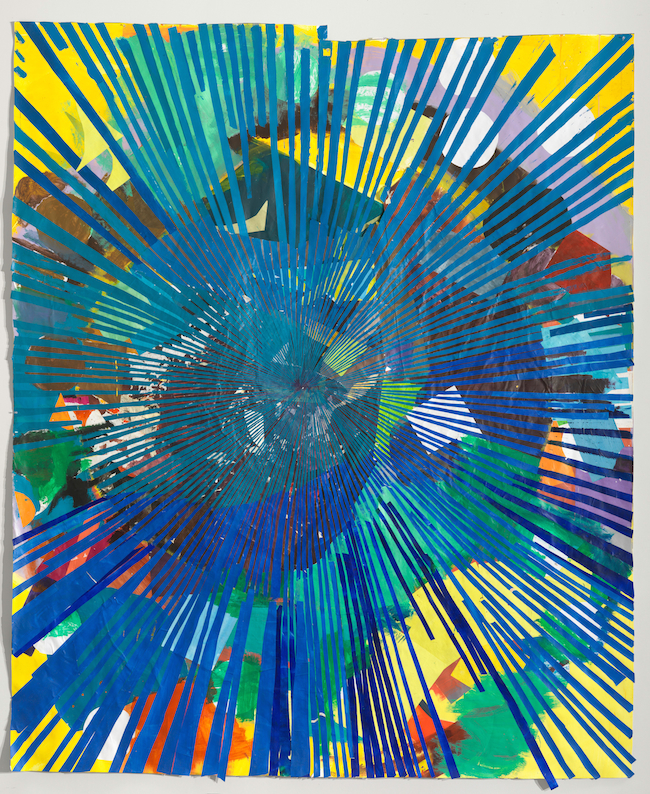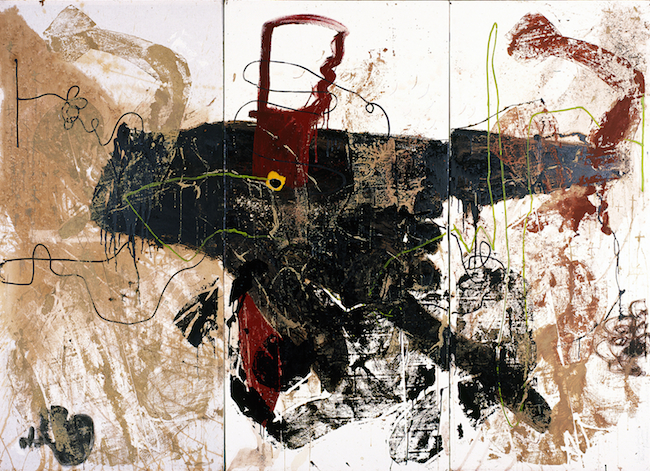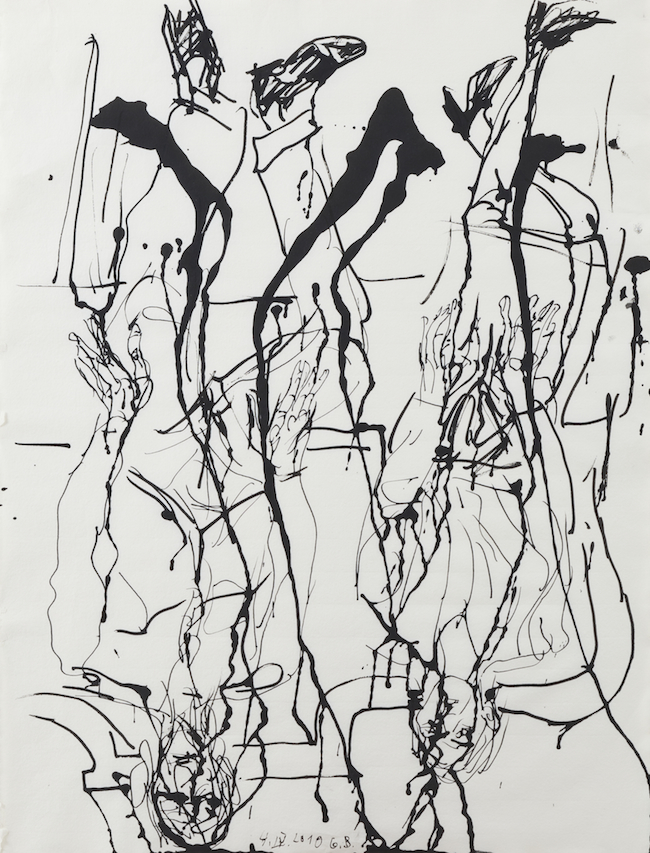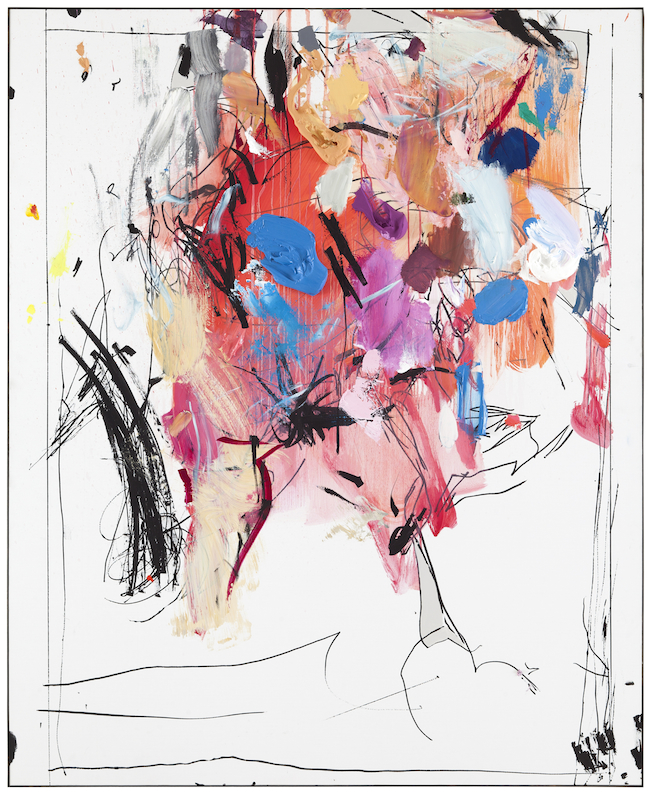
It gives meaning to my life
An interview with Finnish art collector Timo Miettinen
27/04/2017
After my attempt at meeting Finnish art collector Timo Miettinen in Helsinki fell through, I managed to set up an interview with him in Berlin, during Art Week. We met at Salon Dahlmann, a building belonging to Miettinen on Marburger Straße 3, the address where he has established an open-to-the-public exhibition space that regularly hosts a variety of cultural programs. The salon has been presenting exhibitions since 2010, featuring works from the “Miettinen Collection”, as well as curated shows done in cooperation with other private collections, art institutions and different curators; the salon also serves as a venue for concerts, art workshops, and related cultural activities. Salon Dahlmann came to its name by way of the building’s previous owner, Hildegard Dahlmann.
Timo Miettinen owns with his sisters the Finnish company Ensto Oy Finland, and while his business life takes place in Finland, his cultural life is mostly based in Berlin. Miettinen reveals that he has always been interested in the linkages between the Nordic countries/Finland and Berlin. Which probably explains why the “Miettinen Collection” can boast with having so many important works by both Finnish and international artists...and why the interior of the salon has been furnished with top-notch Finnish and German design pieces. It is important to note, however, that the collection is comprised of artworks by contemporary artists of various generations and nationalities. For the entrance of the building, the artist Björn Dahlem has created a permanent light installation entitled “Lokale Gruppe”, while the courtyard of the house accommodates “Säulenskulptur”, a sculpture by Hans Arp. Artists represented in the collection include Georg Baselitz, Louise Bourgeois, Monica Bonvicini, André Butzer, William Copley, Matthias Dornfeld, Luis Gordillo, Peter Halley, Secundino Hernández, Kaarina Kaikkonen, Matti Kujasalo, Heikki Marila, Kirsi Mikkola, Jussi Niva, Albert Oehlen, Janne Räisänen, Aurora Reinhard, Anselm Reyle, Julian Röder, Helene Schjerfbeck, Marianna Uutinen, and Manolo Valdés, among others.

Julian Röder. Thessaloniki II, Greece, 2003. C-print. 50 x 74 cm. Courtesy Salon Dahlmann | Miettinen Collection, Berlin/Helsinki
Timo Miettinen has had a close connection with art ever since he was fifteen years old. Together with his mother, he collected Finnish landscape paintings of the nineteenth and twentieth centuries. He turned to contemporary art upon the enthusiastic urging of his wife, Iiris Ulin. In pointing out that it is important for him to do something for young artists, as well as to bring the accomplishments of Finnish artists to a broader world audience, Miettinen also reveals that for him, the art scene is also an environment in which people from different circles can meet. “I wouldn’t want to exaggerate the role of art, but it is an option that just might help us unite,” he replies when asked how art can influence politics, continuing with: “Salon Dahlmann is a meeting place where we can encourage understanding. This is what I feel is important, although my role is very small in all that.”
You have been collecting art together with your mother since you were 15 years old. Those, however, were Finnish classic landscape paintings of the 19th–20th centuries; what was the turning point that made you switch to the collecting of contemporary art?
I am a collector-type of person. When I was younger, I collected coins, stamps, etc. A very crucial event was when I first met my present wife fifteen years ago. She is an architect, and very interested in art. So, we started to collect art together when we got married in the 1990s; but our interest in contemporary art arose around the years 2002–2003. There had been some moments before then when we had turned our attention to contemporary art, but not so much, and not that determinedly.
We try to choose artworks together if we can, but my wife is not a collector-type of person. She just loves art, and I am the one who is more interested in collecting.
Does this mean that for you, it is more about collecting than about the art itself?
No, it is about the art, but the collecting part is very important. The whole collection is for the purpose of art, not vice versa, because I don’t see it as a commercial project – I don’t sell these artworks. Also, apart from the important possessions that we have in the collection, for me it has always been important to promote young artists. This is what we do also in Salon Dahlmann – we always try to show the artworks of young emerging artists.

Jani Leinonen. Truth or Lie, 2012. Acrylic on wood. 100 x 80 x 6 cm. Courtesy Salon Dahlmann | Miettinen Collection, Berlin/Helsinki. Photo: Roman März
What was the first contemporary artwork that attracted your attention and became part of your collection?
Around 2004 we bought a large-scale artwork by the American artist Donald Sultan. And then, the work of Pierre Alechinsky, who worked in France and belonged to the CoBrA group. Once I had bought artworks by these two artists, I started to think about the idea of collecting contemporary art seriously; also, about promoting the art scene in Finland, and showing Finnish and international artists in my space in Berlin. As I had spent many years in Germany, I thought that German art could be something of interest. In the beginning, when we had a new apartment in Helsinki, we were not really thinking of ourselves as being “collectors”. We just wanted to refurbish our apartment and have something new on the walls. Besides, I wanted to please my wife and let her have the joy of finding good pieces of art. But then I realized that you can do much more with art, and now we have stock in Berlin and in Finland, as well as in our public space, of course.
How many artworks do you own?
We have about 800 artworks – quite a lot of sculptures, paintings, drawings, and now, also photography. I don’t have any videos...perhaps later. And I don’t have much installation art either. However, that might change because now I am in the members committee of the Kunst-Werke museum [KW Institute for Contemporary Art – ed.] in Berlin. My vision about art has broadened; it is different than twenty years ago. I still love paintings, but there is so much interesting art apart from paintings. It is an amazing feeling to discover something new every day! I am a chairman and board member of a couple of technology companies, so this is like compensation for my business life – I have art. It gives meaning to my own life; it enriches my life, and I would like to share it with others. I think it is important for a collector to share – not to keep everything hidden away in an apartment, but to go public and share opinions and thoughts about art with others.

Kirsi Mikkola. Bleu, 2012. Collage, acrylic. 277 x 231 cm. Courtesy Salon Dahlmann | Miettinen Collection, Berlin/Helsinki
You have opened a public space in Berlin. Do you also show your collection in Finland?
In Helsinki it is different – I want to be a little more private there because Finland is very small. However, it is very easy to visit my office in downtown Helsinki where a part of our collection is on view; you just need to make an appointment. There is also the restaurant Ragu, on Ludviginkatu in Helsinki, which was designed by my wife, and there are always artworks from the collection on display there.
But of course, we are more public in Berlin than in Helsinki. I have always been interested in the connection between the Nordic countries/Finland and Berlin.
We have quite a lot of German and Finnish artworks in the collection. I am a Finn, and it is important for me to show art from Finland in Berlin; but I also have pieces by artists from other countries. For example, the American artist John Kleckner, who you can see here, and artworks by Russian artists – although I don’t have much of them, maybe four or five. Russian artists would be very important and interesting to follow, but there is so much art that one has to maintain a little bit of focus.
Is there any focus or general concept for your collection?
That is very difficult to say...if you go through the collection, you can find different kinds of subgroups, but I am very open to new discoveries. And I buy what I like. However, sometimes I ask the opinion of our team – I am already 60 years old, and a 25-year-old might have some new ideas.

Felix Droese. Schmutzige Geschichte, 1999. Oil, bitumen, soil, wood print on canvas, 3 parts. 220 x 300 cm. Courtesy Salon Dahlmann | Miettinen Collection, Berlin/Helsinki. Photo: Manos Meisen
Are there any criteria that help you decide what to buy and what to pass on?
I have only one criterion when I buy art – in the beginning, I don’t want to know the name of the artist. It doesn’t mean anything to me if the artist is well known; the most important thing is the artwork itself.
I think that this [points to the painting on the wall] is an amazing artwork because of its visual qualities, but I also like its content. It’s a depiction by Felix Dröse, which deals with Yugoslavia during the civil war theme. It is a very touching piece. In the beginning, when I started collecting, I looked for beautiful art that could be a part of the decor. Nowadays, what I appreciate is if I can find some content or message in the artwork, like in this case. But I don’t have any specific system for buying art. Of course, I do follow some artists – for instance, I have a couple of artworks from the famous German artist Albert Oehlen, and I know that I would like to have his painting from that or another period, or if I cannot afford the painting, I would like to buy a drawing. I have maybe ten or twenty artists whom I follow.
I have read that you buy artworks not only from galleries, but also from unknown artists who are not represented by a gallery.
Generally, of course, I buy from galleries, but it is important to help artists that aren’t represented by a gallery. We try to go to artists’ ateliers. If I can’t go, I ask my team – Sophie or Eemil – to go and see what they would recommend.
Recently I was at the Academy of Fine Arts in Vienna, and I bought some works by young artists that were recommended by the professor – the famous Finnish artist Kirsi Mikkola. (She is the first professor from Finland at the Vienna Academy of Fine Arts, and I also have her artworks in the collection.)

Georg Baselitz. Ohne Titel, 4 IV, 2010. Ink on paper. 66 x 50 cm. Courtesy Salon Dahlmann | Miettinen Collection, Berlin/Helsinki. Photo: Roman März
Do you like the feeling you get when you discover a new artist that you like?
Of course, that is always interesting! For example, this artist [points to the painting on the wall]; it is a very nice work by an artist who was working by hanging artworks for expositions at Salon Dahlmann. I didn’t even know he was an artist. When I went to his studio, I was totally amazed at how beautiful his works were. I have great hopes that he will have a good career.
Our foundation – and I, personally – think that it is important to try to do something for the young artists. If you have money, you can always buy an expensive Damien Hirst or whatever, but then that is only a monetary investment. First of all, I don’t have enough money to buy a Damien Hirst, but even if I could, I don’t know if he would interest me. It is much more interesting to think about who will be famous in the future, and to support them.
However, apart from emerging names, I do have quite a lot of famous artists – Baselitz, Albert Oehlen, Franz West – because I decided early on that I want to have good art from Germany. There are so many artists in the world that it is difficult to choose, but at the same time, there is quite a lot of art that I don’t like.

Secundino Hernández. Melted, 2013. Gouache, acrylic, resin, oil on canvas. 162 x 132 cm. Courtesy Salon Dahlmann | Miettinen Collection, Berlin/Helsinki. Photo: Jussi Tianinen
What would you name as the highlights of your collection?
One of the highlights is a young artist whom we discovered ten years ago – Secundino Hernandez, who is a rising star now. We have quite a lot of his artworks. Then I have many interesting works by Finnish artists, such as Leena Luostarinen (one of the most important artists in Finland), and Jani Leinonen (his artworks are a critique on consumerism), for instance. In 2016 we had my big anniversary exhibition titled In Wonderland, which I had curated – there we had many highlights that I like.
Have you made any mistakes as a collector?
I think that yes, I have. For example, I bought Russian Suprematist works in the early 1990s, in Finland. I brought them to the Ateneum Museum, and they were all fakes and copies. So, that was not a good thing... But what can I say – I should have understood that the prices weren’t high enough. Of course, I regret it, but luckily, it was not a big investment.
I have also bought some other artworks that I’m not so fond of anymore, but I still have them in the collection because they are a part of my past. I haven’t sold anything.
Do you collaborate with other collectors?
Yes, we have a collectors’ forum in Berlin, Berlin Collectors (berlincollectors.com). The collectors who go public – we stick together. Of course, we all have our own programs, but we try to cooperate as well. For example, in 2015, during the abc art fair, we organized the collectors show; we also organize collectors’ dinners, etc. The purpose of a collectors’ forum is to inform each other about interesting public collections you can visit, to exchange information, to discuss the curating of shows from private collections in Berlin, and so on.
In regards to Finland, there are many collectors and important collections there, but they stick to Finnish art; only five or six collectors have gone into international collecting.
What do you think is their reason for focusing only on Finnish art?
Maybe because it is easier; international collections are a bit costly, and they take up time to develop – you need to go to fairs, to keep yourself updated about what’s going on in the art world. I find it very positive that Finnish artists are being bought – if not by foreign clients, then at least by Finnish one. However, for me personally, the international scene is important – I am proud of Finland, but I also like other countries. That’s why I find it very interesting to be in Berlin – because this art scene is so international. It makes sense, and it is also great fun.
I always try to show Finnish artists at Salon Dahlmann in conjunction with international ones, so that one can get a sense of comparison and see how globalized the art is today – there are so many similarities in the art of different countries.
How important for you is it to communicate with artists?
I find that it enriches my life. I know quite a lot of young artists and curators. I don’t spend too much time with them, but I try to whenever I can, especially when I am in Germany.
My cultural life is more or less in Berlin, whereas my business life is in Finland. Berlin is a very vivid and active place; sometimes when I come back to Finland from Berlin, I sleep for two days. I also think that Berlin will develop in the future – it is already a city of art, and in that sense, it will become even more important in ten years. For example, this area of Berlin – the good old West – is emerging now after having been almost forgotten ten years ago, which is when I first came here.

Secundino Hernández. Untitled, 2017. Acrylic on canvas, 196 x 451 x 4 cm. Courtesy Salon Dahlmann | Miettinen Collection, Berlin / Helsinki
Why did you choose this neighborhood in which to open your space?
I like West Berlin because I feel familiar with it – I lived for three or four years in West Germany. When I bought this house in Charlottenburg ten years ago, I thought it was like in Sleeping Beauty – I was pretty sure it would eventually change. And I was right – many important galleries are coming here now. East Berlin was a trendy, hyped-up thing for some time, but now the art scene is moving back to the good old West.
Going back to the life of a collector – do you see that you have any influence on the general art scene and/or market, as a collector?
Art collectors are important; they are absolutely needed because they have money and they buy art, sometimes even more than museums do. So, the art market is very much in the hands of private collectors. Which is as good as it is bad. Sometimes there is too much commercial input going into the market, and the prices for some artists might go up too high. It is not a healthy system, I have to say, but we don’t have a better one. I think that an artist’s career should develop incrementally and gradually, but this is just my vision and hope. I don’t really think that anything much can be done to essentially change the market because human greed always has been, and always will be, present.
If one looks into the distant future, it doesn’t really matter that much because in the end, the most important thing is the quality of the artwork, not its price. Ultimately, the value of an artwork will have been decided partly by the collectors, but there are also very many curators and professional people who know more about art and art history, and who also play an important role.
There’s a certain question that I always ask – do you believe that art can change the world?
Partly, yes – both art and culture. We currently live in very dangerous times – there are a lot of political tensions in the European Union, there is the war in Syria, and the refugee problem in Europe. Art is something that unites us, it is something that is truly global. We can also try to use art and culture to help people understand and respect each other. But of course, this is not the only way. You can also try to influence politics with art.

Exhibition “ach, die sind ja heute so unpolitisch“ (13.09.–26.11.2016) at Salon Dahlmann. Artworks from the Collection Haus N and Wemhöner Collection. Photo:
How can you influence politics with art?
Making artworks like this one, about the conflict in Yugoslavia; organizing art events like Manifesta, which took place in Saint Petersburg, for instance. Because that allows people to get a different point of view in places that are isolated in terms of information flow, like Russia. I wouldn’t want to exaggerate the role of art, but it is an option that just might help us unite. Of course, art in the hands of tyrants is also dangerous because then it only serves as propaganda; we don’t need that.
Art is an environment in which people from different circles can meet. Salon Dahlmann is also a meeting place where we can encourage understanding. This is what I feel is important, although my role is very small in all that. I can give you another example – I am a member of the Alvar Aalto Foundation. One of his famous architectural projects – the library – is situated in Vyborg (Russia), a territory which used to belong to Finland until 1939. During that period of time it was totally destroyed, but the library was recently refurbished with the help of Finnish and Russian funds – that was a nice example of cooperation between Russia and Finland. As a member of the board, I participated in the project by organizing an exhibition on the Vyborg library by Alvar Aalto at Salon Dahlmann. It was my honor to invite the ambassadors of both Russia and Finland to the opening.
It is important to have contact among people, and art can help with that. It is difficult, but it is possible. At least, this is my personal mission. I cannot do much as one person, but it is nice that I can at least help spread the message.